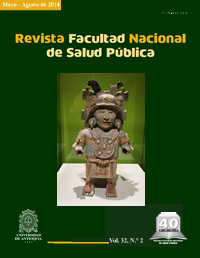Living Under a Bridge: Life and Death; Two Ways of Starting Something
DOI:
https://doi.org/10.17533/udea.rfnsp.16697Keywords:
ethnography, homeless people, health, illness, health servicesAbstract
Downloads
References
(1). Tirado A, Correa M. Accesibilidad de la población habitante de calle a los programas de promoción y prevención establecidos por la resolución 412 de 2000. Investigaciones Andina. (Artículo en internet) 2009; 11 (18) (Consultado marzo 23 de 2012) Disponible en: http://www.redalyc.org/articuloBasic.oa?id=239016503003.pdf.
(2). Departamento Nacional de Estadística - DANE. Boletín General 2005 Necesidades Básicas Insatisfechas (NBI) (Documento de in-ternet) (Consultado junio 22 de 2012) Disponible en: http://www.dane.gov.co/files/investigaciones/boletines/censo/Bol_nbi_cen-so_2005.pdf.
(3). Laurell C. La Salud - Enfermedad como proceso social. Cuader-nos Médico Sociales. 1982; 1 (19): 7 - 20.
(4). Franco S. Proceso Vital Humano - Proceso salud enfermedad: una nueva perspectiva. Ética, Universidad y Salud. Santa Fe de Bogo-tá D.C.: Universidad Nacional; 1993.
(5). Saucedo I, Taracena B. Habitar la calle: pasos hacia una ciudada-nía a partir de este espacio. Revista Latinoamericana de Ciencias Sociales, Niñez y Juventud (Artículo de internet) (2011 mar 18); 1 (9): 269 - 285. Disponible en: http://www.scielo.org.co/pdf/rlcs/v9n1/v9n1a15.pdf.
(6). Correa M. Para una nueva comprensión de las características y la atención social de los habitantes de calle. Revista Eleuthera. 2007; 1: 91 - 102.
(7). Moreno E. Desempeño ocupacional: dimensiones en los ciudada-nos y ciudadanas habitantes de la calle. Umbral científico. 2003; 2.
(8). Anzola F, Cerón F. Plan de ordenación y manejo de la microcuen-ca de la quebrada La Picacha Municipio de Medellín. Medellín: Área Metropolitana; 2008.
(9). Anzola F, Cerón F. Quebrada La Picacha. (Documento de inter-net) (Consultado febrero 15 de 2013) Disponible en: http://desas-tres.usac.edu.gt/documentos/pdf/spa/doc7741/doc7741-3b.pdf.
(10). Taylor S, Bogdan R. Introducción a los métodos cualitativos de investigación. Barcelona: Paidós; 1992.
(11). Colombia. Ministerio de Salud. Resolución 8430 de 1993 por la cual se establecen las normas científicas, técnicas y administrati-vas para la investigación en salud. Bogotá: El Ministerio; 1993.
(12). Hurtado M, Giraldo A, Forero C. Significados de la salud para los niños en situación de la calle en Medellín (Colombia). Index Enferm. 2011 Tercer trimestre; 20 (3): 147:150. DOI: https://doi.org/10.4321/S1132-12962011000200002
(13). Correa M. Para una nueva comprensión de las características y la atención social a los habitantes de calle. Eleuthera. 2007 enero - diciembre; 1: 91 - 100.
(14). Giraldo MM. Habitantes: una aproximación a las interacciones de los habitantes de calle. (Trabajo de grado en Trabajo Social). Me-dellín: Universidad de Antioquia. Facultad de Ciencias Sociales y Humanas; 2005.
Downloads
Published
How to Cite
Issue
Section
License
Copyright (c) 2021 María A. González V., Daniela Blandón Ch., Juliana A. Quiceno V., Álvaro Giraldo P., Constanza Forero P.

This work is licensed under a Creative Commons Attribution-NonCommercial-ShareAlike 4.0 International License.
The contents of the articles are the responsibility of the authors
The editorial committee has editorial independence from the National School of Public Health "Héctor Abad Gómez" of the University of Antioquia.
The editorial committee is not responsible for aspects related to copying, plagiarism or fraud that may appear in the articles published in it.
When you are going to reproduce and disclose photographs or personal data in printed or digital format, informed consent is required. Therefore, this requirement is required of the author at the time of receipt of the manuscript.
Authors are responsible for obtaining the necessary permissions to reproduce any material protected by reproduction rights.
The authors preserve the moral rights and assign the economic rights that will correspond to the University of Antioquia, to publish it, distribute electronic copies, include them in indexing services, directories or national and international databases in Open Access, under the Creative Commons Attribution license -Not Commercial-Share Equal 4.0 International Commercial (CC BY-NC-SA) which allows others to distribute, remix, retouch, and create from the work in a non-commercial way, as long as the respective credit and license are granted. new creations under the same conditions.
The authors will sign the declaration of transfer of economic rights to the University of Antioquia, after the acceptance of the manuscript.
The editorial committee reserves the right to reject the articles whose authors do not offer satisfactory explanations about the contribution of each author, to meet the criteria of authorship in the submission letter. All authors must meet the four criteria of authorship according to ICMJE: "a) .- That there is a substantial contribution to the conception or design of the article or to the acquisition, analysis or interpretation of the data. b) That they have participated in the design of the research work or in the critical review of its intellectual content. c) .- That has been intervened in the approval of the final version that will be published.d). That they have the capacity to respond to all aspects of the article in order to ensure that issues related to the accuracy or integrity of any part of the work are adequately investigated and resolved. "












 --
--  --
--
